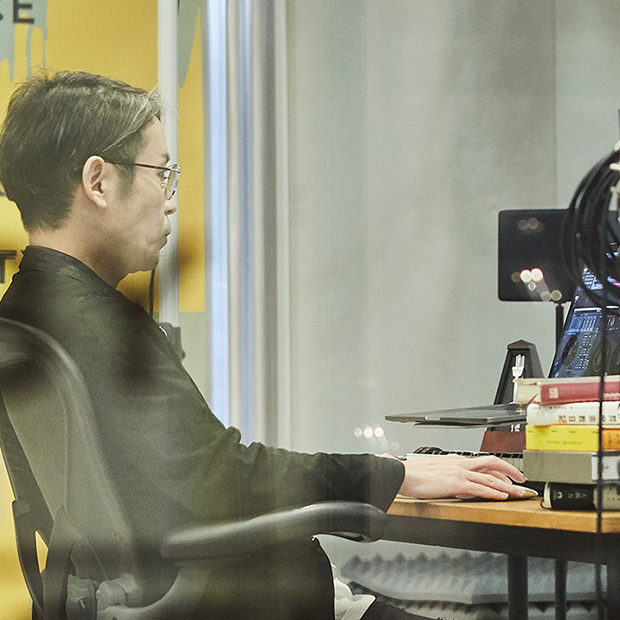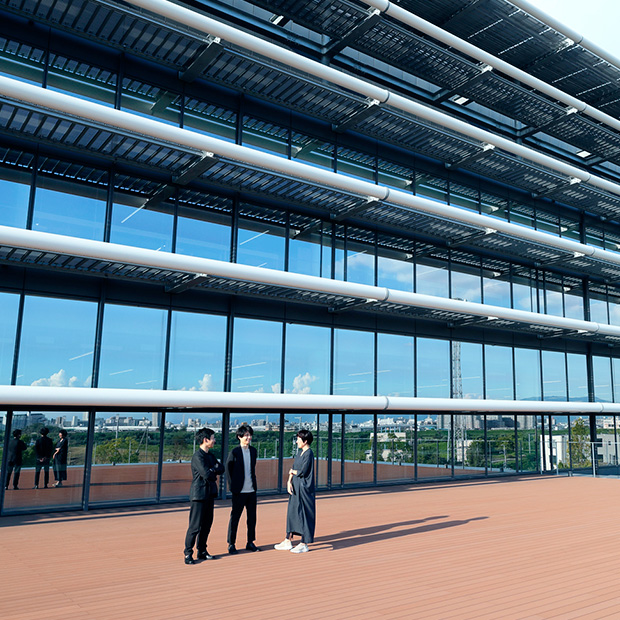As a creative director, Dai Fujiwara is engaged in design in a wide range of fields, using unique methods to link science and manufacturing, and society as a whole with the local community. We spoke with him recently and asked him to share from his own unique perspective, some details regarding how to link these different worlds, and what he thinks about conveying and perceiving air.

Polka Dots – Secret to Seamless Shonan Continuity
Mr. Fujiwara’s office is on a hill, overlooking the deep blue sea of Shonan along the coast of Sagami Bay in Kanagawa Prefecture near Tokyo. With the sea to the front and surrounded by green on all three of the remaining sides, it’s a very pleasant environment, blessed with the pounding of the waves and the sounds of the mountains. Countless clients have no doubt made their way up this hill to ask him to work on projects, for both corporate and community interests.
“As a design and consulting firm, we design and create seamless solutions that take into consideration the particular challenges and management characteristics of our clients, and which help to give them a competitive advantage. What I mean by “seamless” is something that is so beautiful that you can’t even see any seams. If these solutions are anything less than seamless, then energy will be lost and wasted, so we do our best to design things in such a way that everything fits together and works perfectly.
As I’m mostly based in Shonan, I provide direction for local community development and participate in integrated design. The “polka dots” serve as a common thread to tie together over 200 shops in six different shopping arcades into a single event. What was really important to me was brainstorming together with everyone involved to come up with a structure that would allow the people of the community to successfully pull off the event.
The overall concept was for each and every one of the polka dots to embody the unique identities of shop owners and tourists alike. Just like dots are linked to form a line and then to form a plane, the polka dots can link together and form something that is larger than individual dots. And that’s how towns grow. Of course the sea’s right there, so that’s where the inspiration to invoke the image of water came from.”

It was Mr. Fujiwara himself who conceived the “Color Hunting” design method, which is used as a way to come up with a design that will be shared by many different people. Using colors that actually exist in nature or the urban environment, he blends watercolor paints while he is still in a particular environment, and then later presents creations based on those colors.
“We came up with the color used for the polka dots using Color Hunting and it was actually based on the color of the sea in Shonan. In the summer, it’s this rich blue color. That’s the color we used. Throughout the event, participating shops in the arcades hang up polka dot noren* or flags which act as a common theme throughout the arcade. Because of the continuity we often get people walking through the arcades saying, ‘that’s beautiful!’”
* A noren is a short curtain hung outside a restaurant or shop to indicate that it is open for business.

Linking the World of Chemicals with Design
This year Mr. Fujiwara was appointed a meister of the Future Center Alliance Japan (FCAJ), an organization to promote and support innovation with which Daikin is also involved. So as you can see, he is not only involved with corporations and local communities, but also government agencies and ministries, actively encouraging innovation among all of these stakeholders.
“It seems like I’m the matchmaker,” he says smiling. “I’m involved in innovation, but also produce the output. An example of this kind of open lab approach to innovation is the brand Veggie Herb, which is made by Tokiwa Phytochemical Co., Ltd. Veggie Herb, which extracts the life of plants using the wisdom of science, is a brand that brings the power of nature to the urban lifestyle, and their main products are condiments where particular attention has been paid to the substances that give life to the body and soul, and of course to flavor. As a specialty phytochemical company, Tokiwa Phytochemical is historically renowned as a company with broad knowhow regarding the extraction, separation, and refining of plant components, but as it had never developed any products that it could sell directly to general consumers, I was involved with them right from the beginning as we worked together on this concept.
As I’m not an expert when it comes to chemicals, we worked together to reformulate the plan many times. We linked the world of science, in the form of chemicals, with the world of manufacturing. I had the privilege of working on everything from packaging and advertising copy, right through the design and development of their website. It has the feel of a luxury medical item, don’t you think?”

Working Towards a Society where Garbage is No Longer Garbage, Just Like in Nature
Mr. Fujiwara uses design as a tool to solve problems over a wide range of fields, so we asked him what he was most focused on right now, and, to be frank, we were rather surprised by his reply.
“Garbage! To put it slightly differently, the problem of death, or elimination: the things that people don’t usually want to think about. I really want to turn them into something of beauty, but it doesn't seem to be that easy, so it has me rather intrigued. It's something I’ve never done before, so it’s kind of interesting as a new area for me. As long as there are problems, they are just begging to be solved. So I’m naturally attracted to them.
I think it’s an area where we’re going to see a lot of innovation in the future. People here and there will tackle and overcome difficult things, so if we can seamlessly link it all up, then we should be able to solve the problems. I think the methods involved are getting better all the time, so if we can just get our heads around it and change our perspective, then we should be able to seamlessly stitch it all together to solve the garbage problem, don’t you think?
Of course, just like it took millions of years for the workings of nature to be perfected, it’s probably going to take quite some time for human society to get to the point where there is no waste. That’s the point when garbage is no longer garbage. There IS no garbage in nature. We have the word “garbage” because not everything is linked in and working seamlessly together at the moment, but if we can achieve that, then I think we can say we’d have a mature, advanced society. Right now, we’re still on our journey, so it’s still probably going to take quite some time.”

Seeing Invisible Air is Normal!
To finish with, we asked Mr. Fujiwara to share his thoughts on “invisible air.”
“It’s something that has always fascinated me. How is the air we breathe today different from what it was like 100 million years ago? Consider, for example, the pyramids. When archaeologists open a royal chamber that has remained perfectly sealed for millennia for the first time, how is the air inside any different from the air outside? If I had air from 100 million years ago in a bottle, I’d be so excited.
Of course air contains things like nitrogen and oxygen, so it can be expressed in absolute terms using a chemical formula. But I think it can be more than that: it might taste different, it could have noise, and that could lead to some form of new value. Now that’s interesting. Right now we’re in the middle of an unprecedented travel boom, so imagine if the purpose of such travel was to breath air. Very quickly you’d have a new business on your hands as people clamored to find which place has the best air. They’d be going to some place to breathe the air because you can’t breathe it anywhere else.
So when it comes to invisible air, in the same way as they have influenza warnings on the weather forecasts – which you could say make the invisible visible – you’d have demands from the market to make other aspects of invisible air visible. So there’s much more to air than merely whether it’s hot or cold, and people will want to know a lot more about it.
In our increasingly information-based society, the notions of “unseen” and “unknown” are slowly disappearing. Although this is kind of a provocative statement, “invisible air” is somewhat of a contradiction. While it would be normal to see it and it should be obvious to everyone, in actual fact it’s invisible, which is somewhat of a problem,” he says with a smile. “So while everything is supposedly known and visible to anyone, in actual fact there is more to air than a mere chemical formula. Which is why I think it would be interesting if we could build on this by giving invisible air attributes and meaning born out of human emotion, and in so doing make it more visible.”













